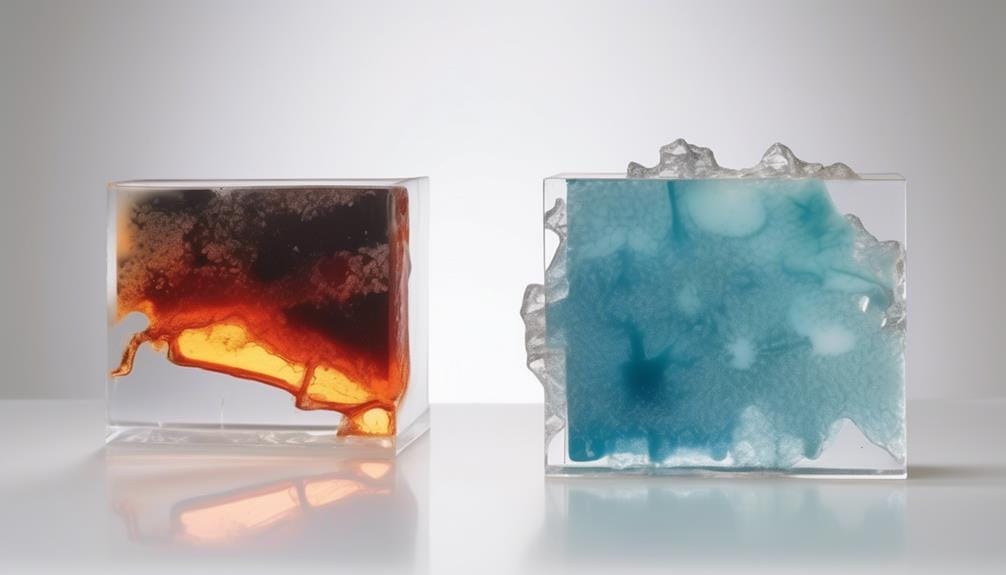Like a shield protecting a knight in battle, the heat resistance of epoxy resin plays a crucial role in preserving the integrity of various surfaces.
But how exactly does epoxy resin withstand high temperatures?
What factors affect its ability to resist heat?
In this discussion, we will explore the intricacies of epoxy resin’s heat resistance, uncovering its secrets, and uncovering the key considerations to ensure its optimal performance.
So, grab your metaphorical armor and join us on this journey to discover the fascinating world of epoxy resin’s heat resistance capabilities.
Key Takeaways
- Heat resistance is crucial for the epoxy resin to withstand high temperatures without compromising its structural integrity, smoothness, and aesthetic appeal.
- Specific epoxy resin formulations designed for high-temperature applications are necessary for optimal heat resistance.
- Factors such as temperature limits, curing process, fillers, exposure time, chemicals present, and object properties can influence epoxy resin’s heat resistance.
- Choosing the right epoxy resin, using high-temperature hardeners, following the manufacturer’s instructions, and selecting appropriate filler materials are important for achieving the desired heat resistance.
Importance of Heat Resistance in Epoxy Resin
The heat resistance of epoxy resin is a crucial factor to consider when selecting the appropriate formulation for specific projects. It determines the resin’s ability to withstand high temperatures without softening, indentations, or loss of shine. Epoxy resin’s high resistance to heat is particularly important in applications where the resin will be exposed to elevated temperatures, such as countertops, bar tops, and tables that may come in contact with hot objects.
Using epoxy resin that isn’t designed for high heat resistance can lead to undesirable outcomes when exposed to heat. The resin may soften, resulting in a loss of structural integrity and diminished performance. Indentations may occur, compromising the smoothness and finish of the surface. Additionally, the resin may lose its shine, affecting the overall aesthetic appeal.
To ensure the desired level of heat resistance, it’s essential to select epoxy resin formulations specifically designed for high-temperature applications. These formulations are engineered to withstand the challenges posed by heat, providing durability and maintaining their properties even when exposed to elevated temperatures. Additionally, using high-temperature hardeners can further enhance the heat resistance of epoxy resin.
It is important to note that epoxy resin’s heat resistance is distinct from its recommended service temperature. Factors such as exposure time, chemicals present, and the properties of the objects in contact with the resin can influence its performance under heat. Therefore, it’s crucial to consider these factors when determining the appropriate epoxy resin formulation for high-temperature applications.
Minimizing heat exposure time is also essential for improving the temperature resistance of epoxy resin.
Factors Affecting Epoxy Resin’s Heat Resistance
When considering the factors that affect epoxy resin’s heat resistance, there are three key points to focus on temperature limits, the curing process, and the presence of filler materials.
The temperature limits determine the maximum heat that the epoxy resin can withstand without losing its structural integrity.
The curing process, including the type of hardener used, plays a crucial role in enhancing the resin’s heat resistance.
Additionally, the use of fillers can reinforce the resin and improve its ability to withstand high temperatures.
Temperature Limits
For optimal heat resistance of epoxy resin, careful consideration must be given to the specific type and formulation, as well as various factors that can influence its temperature limits. The temperature limit of epoxy resin can vary depending on the type and formulation used.
Exposure time, presence of chemicals, and the type of object in contact with the epoxy resin can also affect its heat resistance. When epoxy resin not designed for high heat resistance is exposed to high temperatures, it can soften, form indentations, or lose its shine. It’s crucial to choose the right epoxy resin for specific projects to avoid such issues.
The choice of hardeners and the curing process can also impact the final temperature resistance of epoxy resin. To enhance temperature resistance in high-temperature applications, it’s advisable to select resin formulated for high temperatures, use a high-temperature hardener, minimize exposure time to high temperatures, and follow the manufacturer’s instructions.
Curing Process
To enhance the heat resistance of epoxy resin, the curing process plays a critical role in determining its temperature limits and overall performance. The following factors are important in the curing process to ensure that the resin can withstand high temperatures:
- Type of hardener: The choice of hardener can significantly affect the heat resistance of the epoxy resin. High-temperature hardeners are specifically designed to withstand elevated temperatures and should be used for applications requiring heat resistance.
- Exposure time: Minimizing the exposure time of the epoxy resin to high temperatures is crucial. Prolonged exposure can lead to degradation and reduce the resin’s ability to withstand heat.
- Manufacturer’s instructions: Following the manufacturer’s instructions for the curing process is essential. This ensures that the resin is cured properly, maximizing its heat resistance capabilities.
Filler Materials
The addition of filler materials significantly influences the heat resistance of epoxy resin. Fillers are substances that are added to epoxy resin to enhance its mechanical properties and modify its behavior in high-heat conditions.
The choice of filler material can greatly impact the temperature resistance of the epoxy resin. Certain fillers, such as aluminum oxide or boron nitride, have high thermal conductivity and can improve the resin’s ability to withstand high temperatures. These fillers act as heat sinks, dissipating heat and preventing it from accumulating within the resin.
Other fillers, like glass fibers or carbon fibers, can reinforce the resin and improve its overall heat resistance.
The selection of the appropriate filler material is crucial in achieving the desired temperature resistance for specific applications.
High-Temperature Performance of Epoxy Resin
What factors contribute to the high-temperature performance of epoxy resin?
Several factors influence the high-temperature performance of epoxy resin:
- Type of Resin: Different types of epoxy resins have varying heat resistance properties. Industrial Clear epoxy resin, for example, is specifically formulated to withstand high temperatures, making it ideal for surfaces like countertops and tables.
- Curing Process: The curing process plays a crucial role in determining the heat resistance of epoxy resin. Proper curing ensures that the resin reaches its maximum strength and stability, allowing it to withstand higher temperatures.
- Additives: Incorporating additives into epoxy resin can enhance its heat resistance. These additives can include fillers, such as ceramic or glass fibers, which improve the resin’s ability to withstand heat and prevent deformation.
- Heat Deflection Point: The heat deflection point or softening point of epoxy resin is another important factor in its high-temperature performance. Exposing epoxy resin to temperatures beyond its softening point can cause irreversible damage, leading to deformation or melting.
Understanding Thermal Expansion and Contraction in Epoxy Resin

Understanding the thermal expansion and contraction behavior of epoxy resin is essential for accurately predicting its dimensional stability under varying temperature conditions. When epoxy resin is exposed to high temperatures, it undergoes thermal expansion, causing it to expand in size. Conversely, when the temperature decreases, epoxy resin contracts and shrinks. This thermal expansion and contraction phenomenon can lead to dimensional changes in epoxy resin, which can be critical in applications where precise tolerances are required.
To illustrate the thermal expansion and contraction behavior of epoxy resin, the following table provides a comparison of the linear coefficient of thermal expansion (CTE) for different types of epoxy resin:
| Epoxy Resin Type | Coefficient of Thermal Expansion (CTE) (10^-6/°C) |
|---|---|
| Clear Epoxy Resin | 45 – 70 |
| Industrial Epoxy Resin | 30 – 50 |
| High Heat Epoxy Resin | 20 – 30 |
It is important to note that these values are approximate and can vary depending on the specific formulation and curing process of the epoxy resin. Additionally, the CTE values provided are for fully cured epoxy resin. During the curing process, epoxy resin undergoes chemical reactions that result in the formation of a solid, cross-linked network. Once fully cured, epoxy resin exhibits its maximum heat resistance and dimensional stability.
Understanding the thermal expansion and contraction behavior of epoxy resin allows for proper material selection and design considerations to ensure the dimensional stability of epoxy resin-based products under high-temperature conditions.
Heat Resistance of Cured Epoxy Resin
When considering epoxy resin for high-temperature applications, it’s crucial to assess its heat resistance once it has been fully cured. Here are some important points to consider:
- Industrial clear epoxy resin is specifically designed to withstand high temperatures once it has undergone the curing process. This makes it an excellent choice for surfaces like countertops, bar tops, and tables that may be exposed to elevated temperatures.
- It’s important to note that the heat resistance of epoxy resin isn’t the same as its recommended service temperature. The recommended service temperature is specific to different uses, such as handling a hot cup of coffee. It is different from the resin’s ability to withstand high temperatures without softening or damage.
- The heat resistance of cured epoxy resin can be influenced by various factors, including the type of resin used, the curing process, the presence of fillers and reinforcements, and the type of hardener employed. These factors play a significant role in determining the resin’s ability to withstand high temperatures.
- Softening of epoxy resin can occur when it’s exposed to temperatures higher than its designed limit. This can result in damage, such as warping or indentations. Therefore, it’s essential to select epoxy resin with a suitable softening point for the intended heat exposure to maintain its strength and properties under high temperatures.
Melting Point of Epoxy Resin

Epoxy resin, once fully cured, exhibits a melting temperature of approximately 500°F or higher, making it highly resistant to heat. This characteristic is crucial for applications where exposure to elevated temperatures is expected. The high melting point of epoxy resin ensures that it remains stable and retains its structural integrity even under extreme heat conditions.
It is worth noting that the melting point of epoxy resin can vary depending on its formulation and intended use. Industrial clear epoxy resins, for instance, are specifically designed to withstand high heat once they’re cured. However, it’s important to use epoxy resin suitable for the specific project to avoid any potential damage caused by heat, such as softening, indentations, or loss of shine.
While the melting temperature of epoxy resin is around 500°F or higher, it’s essential to consider the recommended service temperature for the application in question. Manufacturers provide guidelines regarding the maximum temperature at which the epoxy resin should operate to ensure its optimal performance and longevity.
To maintain the heat resistance of epoxy resin, it’s crucial to follow the manufacturer’s instructions accurately and use epoxy resin with suitable heat resistance for the intended application. By doing so, you can ensure that the epoxy resin will withstand high temperatures without compromising its structural integrity or performance.
Heat Resistance of Epoxy Resin in Practical Applications
To ensure the optimal heat resistance of epoxy resin in practical applications, it’s imperative to carefully select the appropriate resin formulation that’s specifically designed to withstand elevated temperatures. When considering the heat resistance of epoxy resin in practical applications, it’s important to keep the following points in mind:
- Choose the right epoxy resin: Selecting an epoxy resin that’s specifically formulated for high-temperature applications is crucial. Industrial clear epoxy, for example, is designed to withstand heat and is ideal for surfaces like countertops, bar tops, and tables that are likely to come in contact with hot objects.
- Follow label instructions: To maintain the temperature resistance of epoxy resin, it’s essential to follow the instructions provided on the label accurately. This includes considering factors such as curing time and usage to ensure optimal performance.
- Consider factors that affect temperature resistance: Factors such as the type of resin, curing process, fillers, reinforcements, and hardeners can affect the heat resistance of epoxy resin. It’s important to choose the right resin for high-temperature applications and minimize heat exposure to ensure the longevity of the epoxy.
Flame Resistance Properties of Epoxy Resin

With its heat resistance, softening point, and recommended service temperature, the flame resistance properties of epoxy resin are determined. Epoxy resin is known for its ability to withstand high levels of heat, making it suitable for various applications where flame resistance is required. Industrial clear epoxy resin, for example, is designed to withstand high temperatures and is commonly used for surfaces like countertops, bar tops, and tables that come in contact with hot objects.
To provide a clear understanding of epoxy resin’s flame resistance properties, the following table outlines the melting temperature and recommended service temperature for industrial clear epoxy resin:
| Property | Temperature Range |
|---|---|
| Melting Temperature | 500º F or higher |
| Recommended Service Temperature | Varies based on specific resin formulation |
It is important to note that epoxy resin can suffer irreparable damage, such as warping or indentations, when exposed to temperatures above its designed limit. Therefore, it is crucial to adhere to the recommended service temperature to ensure the flame resistance properties of epoxy resin are maintained.
Several factors can affect epoxy resin’s temperature resistance, including the type of resin, curing process, fillers, reinforcements, and hardeners used. By considering these factors and following the recommended guidelines, epoxy resin can provide excellent flame resistance properties in various applications.
Heat Resistance of Two-Part Epoxy
When considering the heat resistance of two-part epoxy, it’s essential to evaluate its temperature range, thermal stability, and heat resistance properties.
The temperature range refers to the upper and lower limits within which the epoxy can maintain its structural integrity without softening or degrading.
Thermal stability measures the ability of the epoxy to withstand prolonged exposure to high temperatures without significant changes in its properties.
Lastly, heat resistance properties encompass factors such as the epoxy’s resistance to heat-induced softening, loss of shine, or other undesirable effects when subjected to elevated temperatures.
Temperature Range
The heat resistance of epoxy resin varies depending on the brand and intended purpose, making it essential to select the appropriate epoxy for specific heat exposure needs. When considering the temperature range of epoxy resin, there are several key factors to keep in mind:
- Industrial Clear epoxy resin is specifically formulated to withstand high heat once cured, making it ideal for surfaces like countertops, bar tops, and tables.
- It’s crucial to use epoxy resin designed for high heat resistance to prevent softening, indentations, or loss of shine when exposed to heat.
- The recommended service temperature of epoxy resin indicates the temperature at which it can withstand objects placed on its surface without damage, such as handling a hot cup of coffee.
Remember that the performance of epoxy resin in relation to temperature resistance can be influenced by factors such as exposure time, the presence of chemicals, and the size/shape of the object.
Thermal Stability
For optimal performance and to ensure the desired thermal stability, it’s crucial to select a two-part epoxy resin with appropriate heat resistance properties. The heat resistance of epoxy resin is a key factor in determining its suitability for applications that involve exposure to high temperatures.
Industrial Clear epoxy resin, specifically designed for high heat resistance once cured, is ideal for surfaces like countertops, bar tops, and tables that are likely to come into contact with hot objects. Using epoxy resin not intended for high heat resistance can result in softening, indentations, or loss of shine when exposed to heat.
It’s important to note that the heat resistance of epoxy resin is distinct from its recommended service temperature, which determines its ability to withstand objects placed on its surface without damage. Various factors, such as the type of resin, curing process, presence of fillers/reinforcements, hardener type, and external factors like exposure time and chemicals, can affect the epoxy resin’s temperature resistance.
Therefore, it’s essential to consider these factors when selecting an epoxy resin to ensure the desired thermal stability.
Heat Resistance Properties
To further explore the heat resistance properties of epoxy resin, it’s important to understand how its formulation and specific characteristics contribute to its ability to withstand high temperatures.
- Formulation: Industrial Clear epoxy is specifically formulated for high heat resistance, making it ideal for surfaces like countertops, bar tops, and tables that may come in contact with hot objects. Using epoxy not designed for high heat can result in softening, indentations, or loss of shine when exposed to heat.
- Recommended Service Temperature: Epoxy resin’s heat resistance isn’t the same as its recommended service temperature. It’s crucial to use epoxy with a suitable softening point for its intended heat exposure to ensure optimal performance.
- Factors Affecting Heat Resistance: The type of resin, curing process, fillers, reinforcements, and hardeners all play a role in epoxy resin’s temperature resistance. These factors impact its practical day-to-day service temperature, so it’s important to consider them when choosing epoxy for high-temperature applications.
Understanding these factors will help you select the right epoxy resin with the necessary heat resistance to withstand the temperatures it will be exposed to.
Heat Resistance of Table Top Epoxy
When considering the heat resistance of tabletop epoxy, it’s crucial to select a resin specifically designed to withstand high temperatures. Industrial Clear epoxy resin is formulated to withstand heat once cured, making it suitable for surfaces like countertops, bar tops, and tables. Using epoxy resin not designed for high heat resistance can result in softening, indentations, or loss of shine when exposed to heat. Therefore, it’s essential to use epoxy resin suitable for the specific project to avoid damage.
The heat resistance of epoxy resin refers to the temperature at which it can essentially melt into a liquid state. Industrial Clear epoxy resin, for example, has a melting temperature of 500º F or higher. However, it’s important to note that the recommended service temperature of epoxy resin, such as Industrial Clear, is specific to different uses, such as handling a hot cup of coffee. To maintain its temperature resistance, it’s crucial to follow label instructions accurately.
Several factors affect the temperature resistance of epoxy resin, including the type of resin, curing process, presence of fillers and reinforcements, type of hardener used, exposure time, chemicals, and object properties. Therefore, when selecting tabletop epoxy, ensure that it’s specifically designed to withstand high temperatures to ensure optimal heat resistance.
Preventing and Fixing Heat Damage in Epoxy Resin

Consider using appropriate techniques and materials to prevent and address heat damage in epoxy resin. To ensure the heat resistance of your epoxy resin, follow these guidelines:
- Choose epoxy resin designed for high heat resistance: Opt for epoxy resin specifically formulated to withstand high temperatures. Industrial Clear epoxy resin, for example, is suitable for surfaces like countertops, bar tops, and tables that are likely to come in contact with hot objects.
- Select epoxy resin with a suitable softening point: Different epoxy resins have varying softening points. Choose a resin that matches the intended heat exposure to maintain its strength and properties under high temperatures without softening.
- Follow label instructions accurately: To preserve the temperature resistance of epoxy resin, it’s crucial to adhere to the manufacturer’s instructions. This includes curing times, temperature limits, and any additional precautions.
In the event that heat damage occurs in epoxy resin, here are some steps you can take to fix it:
- Sand and refinish the damaged area: If the heat has caused surface imperfections or loss of shine, sanding the damaged area and applying a new coat of epoxy resin can help restore its appearance.
- Assess and reinforce structural integrity: If the heat has compromised the structural integrity of the epoxy resin, such as causing cracks or indentations, evaluate the extent of the damage and reinforce the affected area with additional layers of epoxy resin or other suitable materials.
- Seek professional assistance if necessary: For extensive or complex heat damage, it may be advisable to consult a professional who specializes in epoxy resin repair to ensure the best possible outcome.
Frequently Asked Questions
Can Epoxy Resin Withstand Heat?
Yes, epoxy resin can withstand heat depending on its formulation and intended application. When using epoxy resin for projects exposed to high temperatures, it is crucial to select a heat-resistant epoxy resin tailored to the specific project to avoid damage.
What Temp Does Epoxy Resin Melt?
Epoxy resin has a specific temperature at which it melts. Knowing this is essential to prevent any mishaps. It’s important to use epoxy resin with suitable thermal stability and consider its melting point for specific projects.
What Is the Best Epoxy for High Temperatures?
The best epoxy for high temperatures depends on various factors, such as the thermal conductivity of the resin and its specific applications. Understanding these factors is crucial in selecting the most suitable epoxy for high-temperature environments.
What Happens When Epoxy Resin Gets Hot?
When epoxy resin gets hot, it can soften, lose its shine, and even warp or indent. The effects of high temperatures on epoxy resin can lead to thermal degradation and a change in its properties.
Conclusion
In conclusion, the heat resistance of epoxy resin is crucial for ensuring the durability and longevity of surfaces that come in contact with hot objects.
Just like a shield that withstands scorching flames, epoxy resin designed for high heat resistance acts as a protective barrier, preventing softening, indentations, and loss of shine.
When choosing epoxy resin for your project, it’s essential to consider its specific heat resistance properties to avoid potential heat damage.





